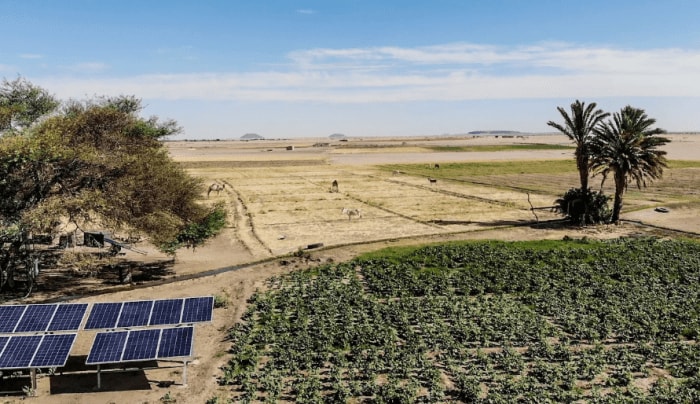Renewable Energy and Climate Change in Sudan

Sudan is taking a new step towards sustainability as it witnessed the launching of the first photovoltaic (PV) power station located near the city centre of El Fashir City in North Darfur State.
Although operating since September 2019, the official inception of the PV was in October 2020. The station started operating with a capacity of 5.27 (4.2 after losses) megawatt-peak (MWp), and can be extended to 50 MWp in the future.
North Darfur is experiencing crucial difficulties when it comes to the stability of electricity. On account of groundwater being the main source of clean water in the area, any risk in electricity supply would lead to a shortage of water. Such a deficiency in urgencies affects the ration of crops and vegetables in the area tragically and threatens the peace of the people of El Fashir.
The PV farm has contributed to promoting and securing electricity and water supply primarily during the summer when electricity supply is the least stable while demand reaches its highest level. Furthermore, the PV system does not require a cooling strategy and consumes no water. It is visually unobtrusive, does not deplete natural resources, or endanger animal or human health, and most importantly, it is quiet and does not cause noise pollution.
Solar energy is not new in North Darfur nor Sudan. It has been used individually by farmers and local producers for several years. Using solar panels has several advantages. The more it is used, the easier farming and local production becomes.
Having a local generation station in El Fashir helps in lessening transportation expenses, the environmental impacts associated with it and the dependence on imported oil.
The El Fashir PV station represents an economically feasible project compared to thermal generation stations such as the Khartoum North station. The solar station diminishes the fuel consumption cost to USD1.5 million annually. Since one gallon of diesel emits around 19.64 pounds of carbon dioxide in thermal stations, switching to PV allows Sudan to reduce its greenhouse gas emissions by 13.8 million pounds per year, leaving no adverse impact on local air quality.
Greenhouse gases keep Earth warm by trapping heat; however, the danger arises as their concentration rises and become out of balance, and as a result, cause climate change.
One of the most immediate and obvious effects of climate change in North Darfur is the increase in temperature that influenced and changed the rainfall patterns. The outcomes of this change can accelerate desertification, cause extreme weather events and drought, drastically vegetation and livestock.
As low carbon technology, further advantage of PV is increasing temperature since the sun is its main resource. It is a powerful way to mitigate climate change. Moreover, it can provide solutions to many additional energy challenges in the country and therefore, contributes to meet growing electricity demand.
It is essential for Sudan to invest more in clean energy in order to develop. Currently, Al Daein’s PV station is under construction and expected to be launched shortly, further leading Sudan towards a sustainable environment.

Alshimaa Asim Ahmed is an electrical and electronic engineering student at University of Khartoum with an interest in climate change. I’m a member of Climate Tracker Org, Fridays For Future Org, and Female and More Org. She was the Vice President of Electrical and Electronic Engineering Students’ Exhibition (EEESE) 2018.




